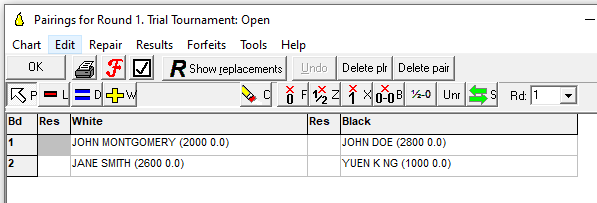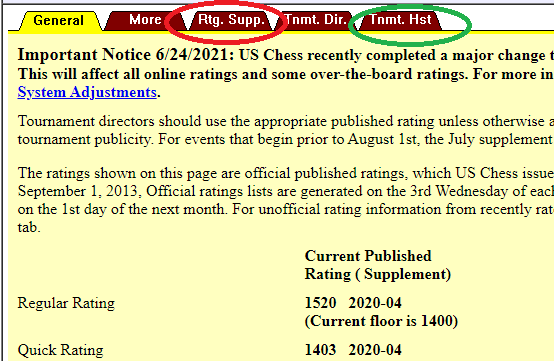Step 1:
Get a USCF ID if you have NEVER EVER played in a rated tournament in the United States. You have to have a "current" USCF membership in order to compete in a USCF rated tournament. This means you have to pay USCF a membership due. This is not necessary for "unrated" events though.
Step 2:
Register to play in a rated tournament. See online lists here of what's available in Texas...
https://new.uschess.org/upcoming-tournaments
http://chess.jliptrap.us/schedule.htm
Step 3:
Get ready by preparing the playing equipment you will need to bring to the event. This includes the following:
Most events require that players bring their own playing equipment. Sometimes, albeit rarely, an organizer may opt to supply boards & pieces only, or otherwise for certain sections of an event. Please make sure you read all tournament publicity guidelines for what you may or may not need to bring to the event. That being said, always prepare to bring EVERYTHING regardless. That means bring a set, board, digital chess clock and writing instrument to every event you attend.
Step 4:
Familiarize yourself with the rules of the game. And I don't mean how to play the game. I mean all the other rules....
Step 5:
Upon arriving to the tournament, usually there isn't a "check-in" process unless otherwise noted by the event organizer or if you see signage suggesting you to.... If you've already registered (check the registration list online for your name) then you just show up to the event about 10-15 minutes before round time to do the following:
Get a USCF ID if you have NEVER EVER played in a rated tournament in the United States. You have to have a "current" USCF membership in order to compete in a USCF rated tournament. This means you have to pay USCF a membership due. This is not necessary for "unrated" events though.
Step 2:
Register to play in a rated tournament. See online lists here of what's available in Texas...
https://new.uschess.org/upcoming-tournaments
http://chess.jliptrap.us/schedule.htm
Step 3:
Get ready by preparing the playing equipment you will need to bring to the event. This includes the following:
- Standard tournament sized board and pieces (vinyl rollup board 20"x20" with 3.75" pieces)
- Digital clock such as this one: basic single time control or this FIDE approved clock which can handle multiple time controls
- Notation book
- Pencils/Pens
- Bottled water
- Analog watch - do not bring smart watches/apple watches/anything that can communicate with a phone
- Earplugs if any noise is an issue
- Outerwear as tournament halls can be a little on the cool side
Most events require that players bring their own playing equipment. Sometimes, albeit rarely, an organizer may opt to supply boards & pieces only, or otherwise for certain sections of an event. Please make sure you read all tournament publicity guidelines for what you may or may not need to bring to the event. That being said, always prepare to bring EVERYTHING regardless. That means bring a set, board, digital chess clock and writing instrument to every event you attend.
Step 4:
Familiarize yourself with the rules of the game. And I don't mean how to play the game. I mean all the other rules....
- about tournament play: http://www.uschess.org/content/view/7328/28/
- tournament rules
- a helpful video! https://www.youtube.com/watch?v=ii-KTHkrVpc
- this is a bit detailed and may not be entirely up to date, but a good general reference for the most part: http://www.gatewaychess.org/Quick_Guide.pdf
- official rules for USCF rated events: https://new.uschess.org/news/7th-edition-rule-book-chapters-now-available-download
- if you are playing in a FIDE rated event, the rules are different! but they will only likely apply to you if you are actually competing within the FIDE rated section; for FIDE Handbook see this link: https://handbook.fide.com/
- all about byes: https://www.danheisman.com/byes.html
- here are some further guidelines for events hosted by The Chess Refinery for their players, click here
- Blitz Rules!
Step 5:
Upon arriving to the tournament, usually there isn't a "check-in" process unless otherwise noted by the event organizer or if you see signage suggesting you to.... If you've already registered (check the registration list online for your name) then you just show up to the event about 10-15 minutes before round time to do the following:
- Find the pairings (usually it is posted either online or on a printed pair chart - SEE EXAMPLE IMAGE ABOVE)
- Find what board you are to sit at, go there and set up your board & pieces
- Black can dictate what equipment they would prefer to use... if white has already set up and you would rather use your set, sure, but make sure it is standard regulation equipment and that you are not 'late' to the board.. if the round has already started, use White's equipment!
- Black gets to say what side of the board the clock goes on unless otherwise set by the tournament director & if you are late to the board, leave it alone b/c the clocks have already started.
- If round starts and your opponent is not there and you are playing black, you start white's clock. If you are playing white, you start your own clock, make a move, and then hit the clock to start black's time. Then you just WAIT for your opponent to arrive. Typical forfeit time is one hour.
- After the game is over, gather your belongings quietly, and make sure you RECORD THE RESULT on the printed pair charts... or if the TD said you have to let them know by raising your hand, then let them know what the result is. Usually PLAYERS are responsible for recording the result of the game themselves on the pair charts. DO NOT ANALYZE & REVIEW your game at the board with your opponent. Step outside of the playing hall.
- What do you do after your round is over? Go chill. Go get a bite to eat. Just relax before next round starts. How do you find out when next round starts? By looking at the tournament publicity where you originally registered for the event.
- After the tournament is over, the TD will submit the results to USCF for rating... this may take a day or two before you see results online on USCF site.
- If you think you have won a cash prize, before leaving the venue speak to the chief TD in charge for further information. Sometimes prizes are sent via electronic payment or mailed check. Prepare to have a photo ID. You may need to fill out a W9 if your prize amount is greater than $600. If other people can 'tie' with you and get the same score as you, wait till their games are finished! Do not bother the TD to try to figure out what you might be winning if the results aren't completely in yet... the TD needs to be keeping an eye on all the last round games instead of helping you GUESS what you might be winning.. =)
- To check your rating: http://www.uschess.org/datapage/player-search.php; click on the name and then tournament history tab to see the latest rating
- Alternatively, if you know your USCF ID, copy and paste the following into a web browser, just replace the XXXXXXXX with your USCF ID#:
http://www.uschess.org/msa/MbrDtlTnmtHst.php?XXXXXXXX - If you see a "P" next to your rating: Before completing 26 games, your rating is provisional and can change drastically after winning or losing. Later, ratings change incrementally based on your result and the ratings of your opponents. When you win, your rating should go up, when you lose, your rating should go down, and when you draw, whether your rating goes up or down depends on whether you were lower rated than your opponent (up) or higher rated (down). US Chess assigns ratings to members who play in official tournaments. Ratings range from 100 to nearly 3000. You can lose rating points as well as gaining them (unlike in bridge) but you cannot lose your US Chess rating. Once rated, always rated.
- There is always going to be a difference between your "supplement rating" and your "live rating". The supplement is published by USCF and is usually what is referenced for pairing purposes in an event. "Live rating" is your latest rating based on the most recent performance at a tournament. See below image for reference. Tnmt.Hst will show you your live rating. Rtg.Supp. will provide your supplement rating.
About Award Distribution
Cash Prizes. These are divided evenly if players tie. Let's say there are 3 prizes for 1st, 2nd and 3rd. The amounts are $100, $75 and $50. If 2 players tie with the same score, then you add the 1st place prize and 2nd place prize, divide it in two. So, $100+75 = $175/2 = $87.50 is awarded to each player who tied. If 3 players tied for 1st, then you would do the same, but add all three prizes.. so each player would get $225/3 = $75 each. Now it gets more complicated if there are other prizes involved outside of just the regular place prizes. See the USCF rulebook, Chapter 2, section 32.
Trophies. These and plaques or other similar items that are non-monetary - are awarded from the use of tie-breaks. See chapter 2, section 33D and section 34 which discusses what the tiebreaks are and how they are calculated.
Get the USCF Rulebook
Kindle version: https://www.amazon.com/US-Chess-Federations-Official-Rules-ebook/dp/B07TYGBMRN/ref=sr_1_4?dchild=1&qid=1627494450&refinements=p_27%3ATim+Just&s=books&sr=1-4
Paperback version: https://www.amazon.com/US-Chess-Federations-Official-Rules/dp/1797716905/ref=sr_1_3?dchild=1&keywords=official+rules+of+chess&qid=1627494651&s=books&sr=1-3
Cash Prizes. These are divided evenly if players tie. Let's say there are 3 prizes for 1st, 2nd and 3rd. The amounts are $100, $75 and $50. If 2 players tie with the same score, then you add the 1st place prize and 2nd place prize, divide it in two. So, $100+75 = $175/2 = $87.50 is awarded to each player who tied. If 3 players tied for 1st, then you would do the same, but add all three prizes.. so each player would get $225/3 = $75 each. Now it gets more complicated if there are other prizes involved outside of just the regular place prizes. See the USCF rulebook, Chapter 2, section 32.
Trophies. These and plaques or other similar items that are non-monetary - are awarded from the use of tie-breaks. See chapter 2, section 33D and section 34 which discusses what the tiebreaks are and how they are calculated.
Get the USCF Rulebook
Kindle version: https://www.amazon.com/US-Chess-Federations-Official-Rules-ebook/dp/B07TYGBMRN/ref=sr_1_4?dchild=1&qid=1627494450&refinements=p_27%3ATim+Just&s=books&sr=1-4
Paperback version: https://www.amazon.com/US-Chess-Federations-Official-Rules/dp/1797716905/ref=sr_1_3?dchild=1&keywords=official+rules+of+chess&qid=1627494651&s=books&sr=1-3
How is my USCF Rating Calculated
https://new.uschess.org/sites/default/files/media/documents/the-us-chess-rating-system-revised-september-2020.pdf
https://new.uschess.org/sites/default/files/media/documents/the-us-chess-rating-system-revised-september-2020.pdf

